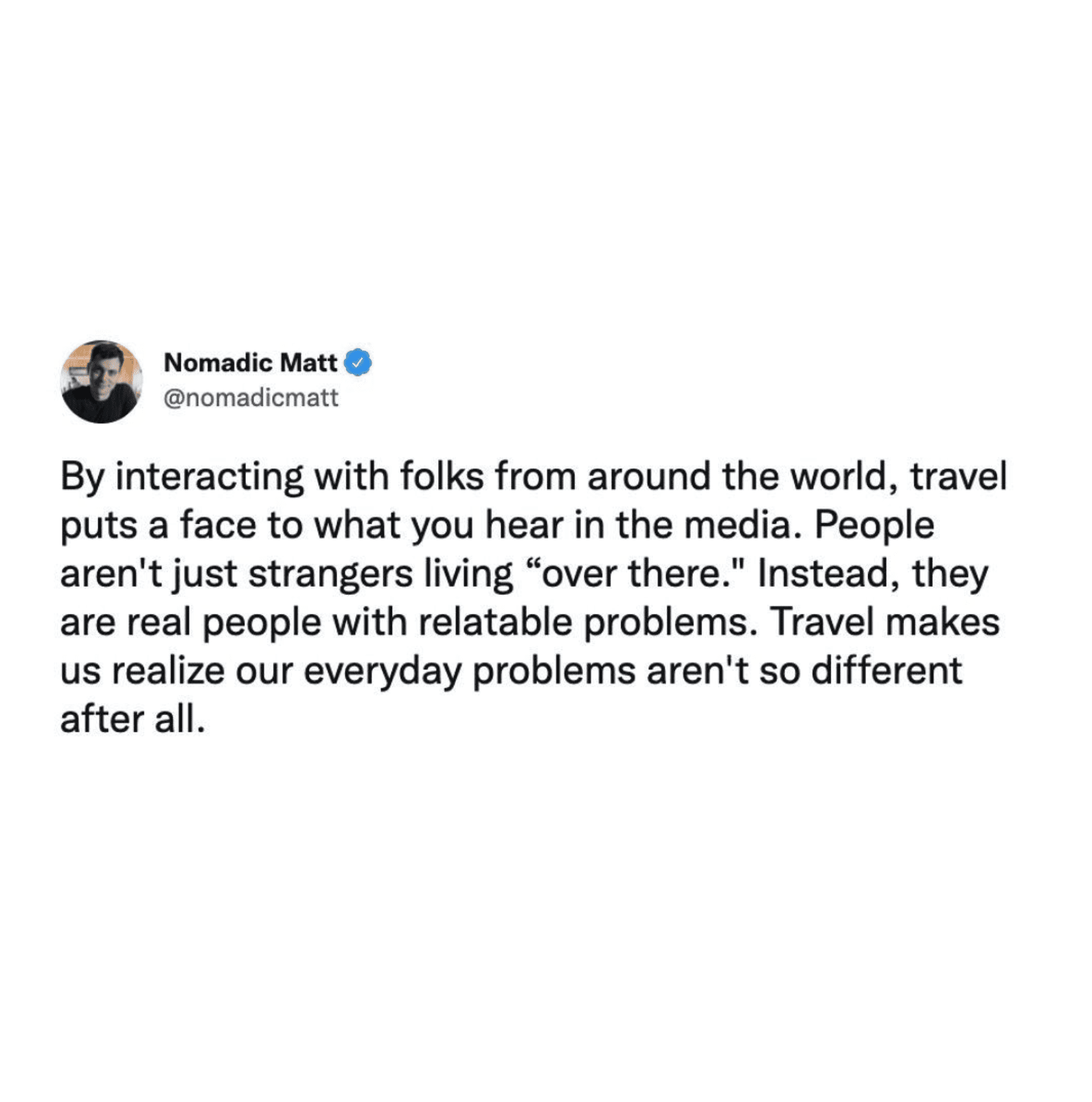
Is it time to bring back the Grand Tour for a modern era?
European aristocrats used to spend several years abroad as part of their education. Can the practice be democratised and updated for a globalised world?
After two years of cautiously staying at home, 2022 has become the year of the revenge trip. Expedia called it ‘the GOAT mindset’ – the Greatest of All Trips. Bookings for long international holidays have increased, with 68% of polled travellers saying they’re going big on travel this year. Bucket list travel is having a moment, and Expedia noted that more people than ever are using travel as a means of “immersing themselves in a destination, culture, and experiences completely different to their own.”
This desire for new experiences and exciting modes of education reminded me of a 17th and 18th-century European tradition: The Grand Tour. Primarily started by the English nobility, wealthy young men (and their tutor-chaperones) from every European country were soon spending years abroad, taking familiar paths to destinations meant to round out their education and refine them.
Of course, the world has changed considerably since then – and so has the approach to the way we travel. But as we start to question how we travel and the impact it has – and perhaps how much we should travel at all – I’ve begun to think about the importance of taking these kinds of trips, and the positive effects they have on broadening our points of view. Is there something to be learned from the original Grand Tours, and can we adapt them for the modern age?

What was the Grand Tour?
For Englishmen of means and youth, the Grand Tour began with a dangerous and costly crossing of the Channel into France. From there, they continued on to Paris, where they might spend several months to a year studying at a local university. Young English elites usually studied French in school, so this was a time to refine their fluency. It was usually the last stop of formal schooling in a classical education.
After France, tourists proceeded over the Alps to Turin, which was usually quickly passed through on the way to Rome and Venice. The goal was to reach them in time for Holy Week in Rome or Carnival in Venice. Particularly ambitious young aristocrats might travel beyond Italy, but most travellers stuck to the traditional route. Once archaeological excavations began in Pompeii in the mid 1700s, southern Italy was added to the itinerary, too. Altogether, the tour could last several months and up to four years.
This length of time was key – a quick breezy trip through a city would give only a shallow impression. The goal of the Tour was for future aristocrats to learn about other cultures and engage with other ways of living. While there was debate about whether or not tourists returned home more mature than they left it, society saw this trip as a formative rite of passage.
If the intention was for young men to come home cultured, it worked. ‘Tourists’ brought home ideas for architecture, art, music, and literature, which they introduced back into English society. After their tours, many held a lifelong love for the places they had visited and the art they had seen.
The goal of the Grand Tour was for future aristocrats to learn about other cultures and engage with other ways of living

George O’Brien Wyndham, 3rd Earl of Egremont, so loved his first tour in 1770 that he took another in 1774. Later in his life, he became a leading collector of antique sculptures and the Old Masters, adding hundreds of artworks to his collection at Petworth House in the South Downs. Some of these can be seen in the background of a portrait of him painted by Thomas Phillips in the 1830s or 1840s.
The novelist William Beckford wrote Vathek immediately after his Grand Tour, which helped popularise Gothic literature. Much of the Italian art Beckford collected during and after his tour is now housed in London’s National Gallery. Beckford also commissioned Fonthill Abbey in Wiltshire in the Gothic Revival style, which he’d been exposed to on his travels.
Similarly, Colen Campbell took a long trip to Italy in the late 1790s, after which he published Vitruvius Britannicus, or the British Architect, which was instrumental in popularising Palladian architecture in Britain. Burlington House on London’s Piccadilly is a famous example of this style.
Ironically, the lower cost of travel made possible by the rise of trains in the 19th century may have played a part in ending the Grand Tour. Mass tourism lessened enthusiasm for the Grand Tour in the aristocratic classes. By the mid-19th century, long trips abroad had fallen out of favour.

Can the Grand Tour come back?
It strikes me that a trip like the Grand Tour is more important than ever. A chance to refine language skills, be exposed to other cultures and make international connections couldn’t be more important in a globalised society.
Trips abroad make people more culturally sensitive, more adaptable, and more confident. (In fact, whenever my back is up against a wall, I find myself thinking, “You travelled for three months in China alone, you can do this.”) Though there’s no bad time, the early twenties are still an ideal age for extended travels, when formal education is finished but the obligations of family and career haven’t kicked in yet.
But can it ever be truly democratised? Long-term travel requires both the financial means and freedom to take a lot of time off of work – or the willingness to go into debt. When I spent two years in France for graduate school, I took out personal loans to cover the costs of travelling outside my studies. I didn’t know when – if ever – I would be based in Paris again. I couldn’t imagine leaving the city when Versailles, Mont-Saint-Michel, Avignon, Marseille, and Reims were right there. It took time to pay the loans off, and I was privileged to even be in the position to make such a decision, but it was worth it.

For most people, international travel remains elusive. The comparison of the Grand Tour to a college student’s study abroad trip (usually associated with an arts education rather than sciences) is inevitable, and is still seen as a chance to refine languages through immersion and to experience another culture.
New modes of long-term travel, like van life, have recreated the length of time of the Grand Tour, but only for people who have the financial means to custom fit a van for themselves. Travel influencers like Matt Kepnes of Nomadic Matt help people find ways to travel for only 50 USD a day, but it still adds up. To recreate the Grand Tour, a two-year trip could cost 36,500 USD at that rate.
2022 has seen an increase in people finally booking bucket list travel, taking The Big Trip they don’t want to miss out on, or contemplating a longer time spent away thanks to the new-found ability to work remotely.
Increasing restrictions about where people can travel and for how long also limits the possibility for long-term immersion. Today, the Schengen region of Europe only allows visitors from certain countries to remain in the area for 90 days at a time without a special visa, severely restricting a resurgence of the traditional Grand Tour. The process of getting a special visa can be expensive, time-consuming and difficult.

Some nations have created options that circumvent this. For instance, in 1975 Australia established a Working Holiday visa, which allows people under 30 to work and holiday in the country for up to 12 months (with renewal available). But the visa is still restricted to people from certain countries and a certain level of English-language proficiency. What’s more, the number of visas issued every year is capped.
Though travel has been made less expensive with industrialisation, a trip of this magnitude is still out of reach for the great majority of people. But if we agree that experiencing the world is key to increased international cooperation, cultural sensitivity, and well-rounded education, then finding ways to make long-term travel possible for people – especially younger people – is an urgent necessity.
That could look like fellowships and scholarships provided by governments, organisations, or individuals. It could be achieved through greater integration of an international corporation’s workforce; for companies with offices in multiple countries, encouraging team members to work abroad could be a way to build irreplaceable bonds.
Increasing standard paid time off at work would help employees take time off without seeing a drop in income; more time off is correlated with higher productivity at work, so it’s good for businesses, too. Extending or creating nationally mandated leave policies are also an important step – the United States is one of only four countries on earth without any nationally mandated leave (the others are North Korea, Sri Lanka and Liberia).
With globalisation increasing our ties to other countries at exponential rates, a resurgence of long-term international travel can only be good for communities. Just like how European elites used to bring home neoclassical ideals, immersion in another culture today can spread ideas and foster connections that should be treasured and encouraged – and that’s never been more important.







